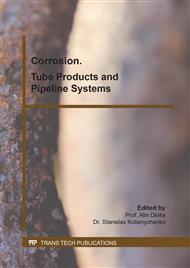[1]
Liu Yangou, Effect analysis of anticorrosion measures for tubes of waterinjectionwell in Shengli oilfield, J.Corrosion &Protection. 24 (2003) 361-362.
Google Scholar
[2]
Mei Zhenhong, Study on internal anticorrosion technology of water injection tubing, D.Southwest Petroleum University, Chengdu, (2014).
Google Scholar
[3]
Lin Haichao, Li Mocheng, Corrosion process for metals beneath coating, J.Corrosion Science and Protection Technology. 14 (2002) 180-181.
Google Scholar
[4]
Shen H B, Liu Q X, Qu Y, Application of graphene in, J.CoaR. Technol. Abstr. 35 (2014) 20.
Google Scholar
[5]
Zhu Y W,Murali S, Cai W W, et al, Graphene and graphene oxide synthesis, properties, and applications, J. Adv. Mater. 22 3906 (2010).
DOI: 10.1002/adma.201001068
Google Scholar
[6]
Lee C G, Wei X D, Kysar J W, et al, Measurement of the elastic properties and intrinsic strength of monolayer graphene, J. Science. 321 (2008) 385.
DOI: 10.1126/science.1157996
Google Scholar
[7]
Bunch J S, Verbridge S S, Alden J S, et al, Impermeable atomic membranesfrom graphene sheets, J. Nano Lett. 8 (2008) 2458.
DOI: 10.1021/nl801457b
Google Scholar
[8]
Topsalcal M, Sahin H, Ciraci S, Graphene coatings: an efficient protection from oxidation, J. Phys. Rev. 85B (2012) 155445.
Google Scholar
[9]
Lin J S, Wang L W, Chen G H, Modification of graphene plateletsand their tribological properties as a lubricant additive, J. Tribol. Lett. 41 (2011) 209.
DOI: 10.1007/s11249-010-9702-5
Google Scholar
[10]
Berman D, Erdemir A, Sumant A V, Few layer graphene to reduce wear and friction on sliding steel surfaces, J. Carbon. 54 (2013) 454.
DOI: 10.1016/j.carbon.2012.11.061
Google Scholar
[11]
Kang Y, Ai J.,The development present situaion and future trends of graphene coadings industry, J. Acetald. Acetic Acid Chem. Ind. (2015) 32.
Google Scholar
[12]
Yu Lifang, Yang Zhijun, Zhou Yongzhang, Zhao Wenxia, Li Hong, Review of application of SEM and environmental scanning electron microscopy in geoscience field, J. Journal of the Graduate School of Sun Yat-sen University. 29 (2008) 54-61.
Google Scholar
[13]
Jing Hong, Study on the local corrosion law of the damaged inner coating of natural gas pipelines, D.Southwest Petroleum University, Chengdu. (2017).
Google Scholar
[14]
Reng Fang, Fabrication and Characterization of Graphene/Epoxy Modified Cyanate Ester Microwave Absorbing Composites, D. Northwestern Polytechnical University, Xian. (2015).
Google Scholar
[15]
Xia Wei, The preparation of graphene /epoxy resin composites and the corrosion protection property under γ-radiation, D. Nanjing University of Aeronautics and Astronautics, Nanjing. (2016).
Google Scholar
[16]
Sun W, Wang L, Wu T, Wang M, Yang Z, Pan Y, et al, Inhibiting the corrosion-promotion activity of graphene, J. Chem. Mater. 27 (2015) 2367-73.
DOI: 10.1021/cm5043099
Google Scholar
[17]
Liu Dan, Preparation of modified epoxy composite coating and study on its tribological properties, D.Kunming University of Science and Technology, Kunming. (2016).
Google Scholar
[18]
Mo M, Zhao W, Chen Z, Yu Q, Zeng Z, Wu X, et al, Excellent tribological and anti-corrosion performance of polyurethane composite coatings reinforced with functionalized graphene and graphene oxide nanosheets, J.RSC Adv. 5 (2015) 56486-97.
DOI: 10.1039/c5ra10494g
Google Scholar
[19]
Thi Xuan Hang T, Truc TA, Nam TH, Oanh VK, Jorcin J-B, PebereN,Corrosion protection of carbon steel by an epoxy resin containing organically modified clay, J.Surface and Coatings Technology. 201 (2007) 7408-15.
DOI: 10.1016/j.surfcoat.2007.02.009
Google Scholar
[20]
Wan Y J, Tang L-C, Yan D, Zhao L, Li Y B, Wu L-B, et al, Improved dispersion and interface in the graphene/epoxy composites via a facile surfactant-assisted process, J. Composites Science and Technology. 82 (2013) 60-8.
DOI: 10.1016/j.compscitech.2013.04.009
Google Scholar
[21]
Hua Zhongsheng, Yao Guangchun, Ma Jia, Zhang Zhigang, Li Si, XPS analysis of nickel layers on carbon fibers, J. The Chinese Journal of Nonferrous Metals. 21 (2011) 165-70.
Google Scholar
[22]
Wu Fang, Interface control and performance research of epoxy-graphene/graphene oxide anticorrosion and wear-resistance composite coating, D. Jiangxi University of Science and Technology, Nanchang. (2015).
Google Scholar
[23]
Yao Hongyan, Study on corrosion and protections for water injection tubing and oil tubing, D. China University of Petroleum, Beijing. (2006).
Google Scholar
[24]
Wang Yaowen, The synthesis and application of polyaniline and graphene nanosheets in anti-corrosion coatings, D. Harbin Engineering University, Harbin. (2012).
Google Scholar
[25]
LIU S, GU L, ZHAO H C, et a1, Corrosion resistance of graphene-reinforced waterborne epoxy coatings, J. Science & Technology, 32 (2015) 1223-230.
Google Scholar
[26]
Wang Haixia, Offshore wind power anticorrosion: Graphene paint came, N. China Energy News, No. 023 edition. (2014).
Google Scholar
[27]
Zhang Lanhe,Li Raosong,Wang Dong,Zhang Wanyou,Liu Chunguang,Wang Xuming, Study on Preparation and Anti-corrosion Properties of Polyaniline/Graphene Waterborne Coatings, J. Proceedings of the CSEE. 35 (2015) 170-176.
Google Scholar
[28]
Zhen Chunsen, Zhao Haiping, Yao Bolong, Wang Langduo, Sun Changqing, Preparation and properties of functionalized graphene modified waterborne polyurethane, J. Acta Materiae Compositae Sinica. 34 (2017) 2643-2652.
Google Scholar



